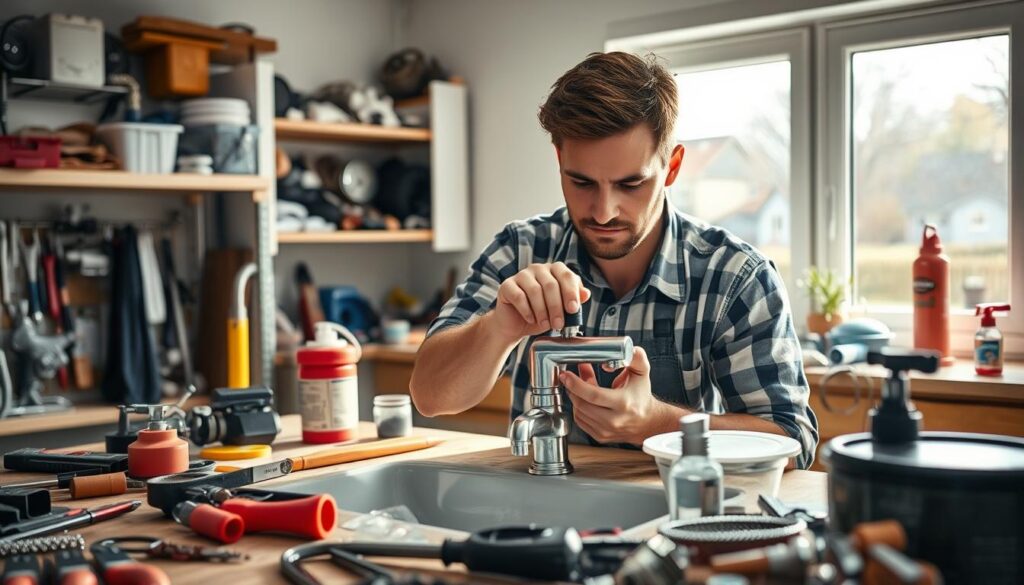Plumbing issues at home can be a real headache, but many of them are easier to fix than you might think. Whether it’s the annoying drip of a leaky faucet or the frustration of a slow drain, having basic knowledge of DIY plumbing fixes can save you both time and money.
For instance, tasks like swapping out a showerhead or replacing a sink sprayer can be done with minimal tools and expertise. You can start by using thread sealant tape, such as Hercules Megatape, for a leak-free connection. Moreover, being aware of simple fixes like using baking soda and vinegar to prevent drain clogs can be very helpful.
Key Takeaways
- Identify common plumbing issues that can be fixed DIY.
- Learn basic plumbing repair techniques to save time and money.
- Understand when to call a reliable plumber near me for complex issues.
- Use the right tools and materials for DIY plumbing fixes.
- Prevent future plumbing problems with simple maintenance tasks.
Understanding Common Plumbing Problems
Understanding the root causes of common plumbing problems is the first step towards resolving them efficiently and preventing future issues. Homeowners often encounter a range of plumbing issues that can lead to wasted water, increased utility bills, and significant property damage if not addressed promptly.
Leaky Faucets
A leaky faucet is not just annoying; it’s also a waste of water. The most common cause is a worn-out or damaged O-ring or gasket. Replacing these parts is relatively simple and can be done with basic tools. For more complex faucet designs, it might be necessary to consult a professional for emergency plumbing solutions.
Running Toilets
A running toilet can waste a significant amount of water. The issue is often due to a faulty flapper or an improperly adjusted float. Checking and adjusting these components can usually resolve the problem. If the issue persists, it may indicate a more complex problem requiring professional attention.
Clogged Drains
Clogged drains are a common issue, often caused by the buildup of hair, soap, and other debris. Using a plunger or a drain snake can often clear the blockage. For more stubborn clogs, chemical drain cleaners can be effective but should be used with caution.
Burst Pipes
Burst pipes can cause significant damage. They are often the result of freezing temperatures, corrosion, or high water pressure. Immediate action is required to mitigate damage, including turning off the main water supply and seeking affordable pipe repair services.
| Issue | Common Cause | Basic Fix |
|---|---|---|
| Leaky Faucet | Worn-out O-ring or gasket | Replace O-ring or gasket |
| Running Toilet | Faulty flapper or float issue | Adjust or replace flapper |
| Clogged Drain | Buildup of debris | Use plunger or drain snake |
| Burst Pipe | Freezing, corrosion, high pressure | Turn off main supply, seek professional help |
By understanding these common plumbing problems and their basic fixes, homeowners can take proactive steps to prevent major issues, potentially saving on costly repairs and reducing water waste. For complex problems, seeking professional leak detection services can be invaluable.
Essential Tools for Quick Plumbing Repairs

Before diving into plumbing repairs, ensure you have the essential tools required for the job. Having the right equipment can significantly reduce the time and effort spent on fixing common plumbing issues.
Wrench Types You Need
An experienced plumbing contractor always has a variety of wrenches at their disposal. The most commonly used wrenches include adjustable wrenches, basin wrenches, and pipe wrenches. Adjustable wrenches are versatile and can be used for a wide range of tasks, while basin wrenches are ideal for reaching and tightening faucet mounting nuts in tight spaces. Pipe wrenches, on the other hand, are used for gripping and twisting pipes.
For more information on the best plumbing tools, you can visit ServiceTitan’s guide or explore resources on World Civil Society for DIY projects.
Plumber’s Tape Explained
Plumber’s tape, also known as Teflon tape, is used to create a watertight seal on threaded pipe connections. It’s a simple yet crucial tool for preventing leaks. To use plumber’s tape effectively, wrap it around the male threads of the pipe in a clockwise direction before screwing on the fitting.
Pipe Cutters and Their Uses
Pipe cutters are essential for cutting through pipes cleanly and efficiently. They come in different types, including manual and ratcheting pipe cutters. Manual pipe cutters are suitable for most DIY tasks, while ratcheting pipe cutters make it easier to cut through thicker or harder pipes.
Quick Fix for Leaky Faucets
Don’t let a leaky faucet waste your water and money; learn how to fix it quickly with our step-by-step guide. Fixing a leaky faucet is a simple task that can be done with basic tools and a bit of knowledge.
Step-by-Step Repair Process
To start, you’ll need to turn off the water supply to the faucet. This is usually done by locating the shut-off valves under the sink and turning them clockwise. Once the water supply is off, you can begin disassembling the faucet to identify the source of the leak.
Disassembling the faucet may vary depending on the type of faucet you have. For a standard faucet, you’ll typically need to remove the handle to access the cartridge or stem inside. Use a screwdriver or wrench as needed, and be careful not to damage any parts.
Once you’ve accessed the internal parts, inspect them for wear or damage. Common culprits include worn-out O-rings, gaskets, or valve seats. Replacing these parts is usually straightforward and can be done with replacement parts from a hardware store.
When to Replace Parts
If you find that the leak is due to a worn-out part, replacing it is usually the best solution. For example, if the O-ring is damaged, you can purchase a replacement O-ring of the correct size and install it. Make sure to clean the area around the new part to ensure a proper seal.
- Identify the worn-out part.
- Purchase a replacement part of the correct size and type.
- Clean the area around the part before installing the new one.
- Test the faucet after reassembly to ensure the leak is fixed.
By following these steps, you can achieve quick and easy plumbing repairs, saving you money and reducing water waste. For more complex issues or if you’re not comfortable with DIY repairs, consider seeking same-day plumbing repairs from a professional.
Simple Solutions for Running Toilets
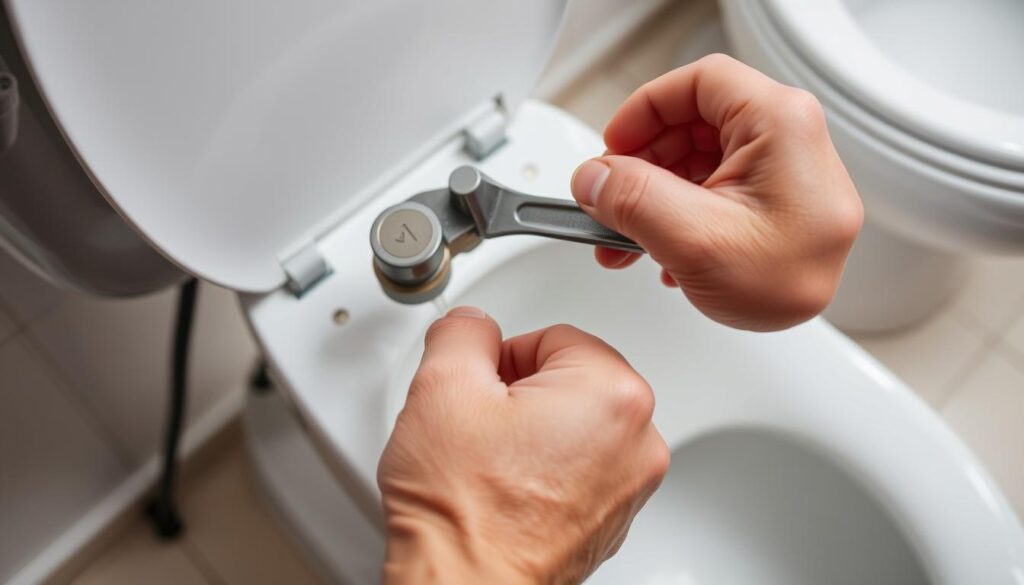
A continuously running toilet is a problem that can often be resolved with some basic troubleshooting. Running toilets waste water and increase your utility bills, making it essential to address the issue promptly.
Diagnose the Problem
The first step in fixing a running toilet is to identify the cause. Common issues include a faulty flapper, improper float adjustment, or problems with the fill valve. Inspecting these components can help you determine the source of the problem.
Inspect the Flapper: The flapper is a crucial component that can cause issues if it’s damaged or not sealing properly. Check for any signs of wear or misalignment.
How to Fix the Flapper
If the flapper is the issue, replacing it is usually a straightforward process. Turn off the water supply to the toilet before starting the repair. Then, remove the old flapper and install a new one, ensuring it’s properly aligned and sealed.
For a reliable plumber near me, it’s always a good idea to have their contact information handy, especially if you’re not comfortable with DIY repairs or if the issue persists after trying these fixes.
Adjusting the float or fixing the fill valve might also be necessary. If you’re unsure about how to proceed, consider seeking fast plumbing services to resolve the issue efficiently.
Clogged Drains: Fast and Effective Techniques
Clogged drains are not just annoying; they can also lead to more serious plumbing issues if not addressed promptly. Understanding how to tackle this common problem can save time and prevent further damage.
Using a Plunger Properly
A plunger is one of the most effective tools for clearing clogged drains. To use it correctly, ensure the plunger is properly seated over the drain, then push down slowly and steadily until you feel resistance, and pull up sharply to create suction. Repeat this process several times to dislodge the clog.
For sinks and other drains, a sink plunger is typically used. It’s crucial to create a good seal around the drain to ensure effective suction. If the clog persists, you may need to consider other methods or tools.
Natural Drain Cleaners
For those looking for an alternative to chemical drain cleaners, natural methods can be just as effective. A mixture of baking soda and vinegar is a popular and eco-friendly solution. Pour 1/2 cup of baking soda down the drain, followed by 1/2 cup of vinegar. Let the mixture sit for a few hours or overnight before rinsing with hot water.
This method works by creating a chemical reaction that helps break down the debris causing the clog. It’s a safer option for your pipes and the environment compared to harsh chemical cleaners.
When to Call a Professional
If your attempts to clear the clog are unsuccessful, it may be time to call a professional plumber. Persistent clogs can indicate a more serious issue within your plumbing system, such as a blockage further down the line or a problem with your sewer connection.
For emergency plumbing solutions, it’s essential to have access to reliable professionals who can diagnose and fix the problem efficiently. Professional plumbers have the tools and expertise to handle complex clogs and other plumbing emergencies.
| Method | Description | Effectiveness |
|---|---|---|
| Plunger | Creates suction to dislodge clogs | High |
| Baking Soda & Vinegar | Chemical reaction to break down debris | Medium to High |
| Professional Plumbing Service | Expert diagnosis and repair | Very High |
Dealing with clogged drains can be frustrating, but with the right techniques and tools, you can often resolve the issue quickly. For more complex problems, don’t hesitate to seek professional help to ensure your plumbing system is functioning properly.
Dealing with Burst Pipes
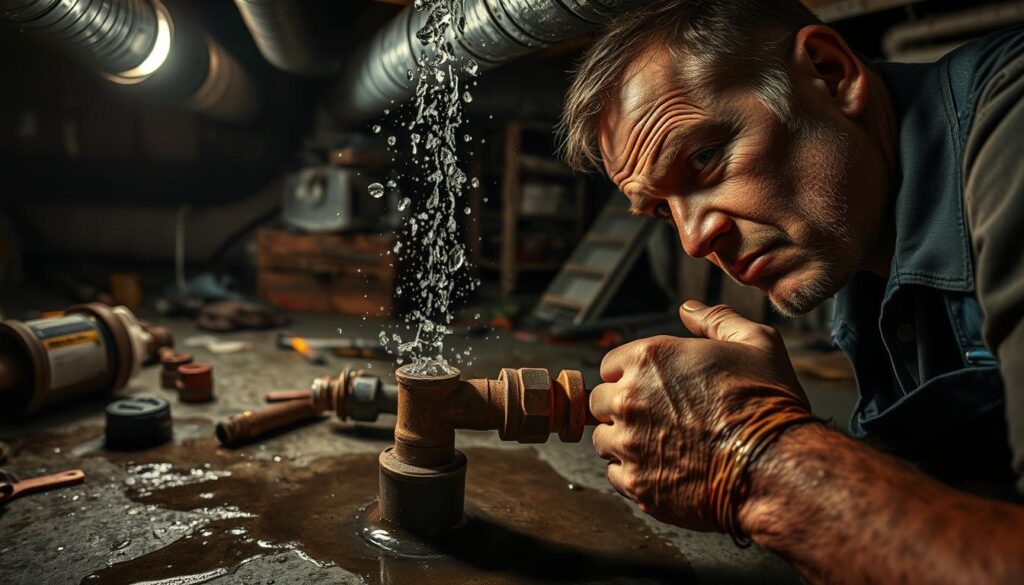
Dealing with a burst pipe requires immediate action to minimize water damage and costly repairs. Burst pipes can lead to significant issues if not handled promptly, including structural damage to your home and potential health hazards from water contamination.
Immediate Actions to Take
When you discover a burst pipe, the first step is to turn off the main water supply to prevent further damage. Locate your home’s main shut-off valve and turn it clockwise to shut off the water supply. If you’re unsure where the valve is located, consult your home’s plumbing diagram or contact a professional for assistance.
For same-day plumbing repairs, it’s advisable to contact a reliable plumbing service that can respond quickly to your emergency. This immediate response can significantly reduce the extent of the damage.
Temporary Fixes with Pipe Repair Tape
While waiting for professional help, you can use pipe repair tape as a temporary fix to mitigate the issue. Pipe repair tape, also known as plumber’s tape or Teflon tape, can be wrapped around the damaged area to seal leaks temporarily. For a more durable temporary solution, consider using a pipe clamp or epoxy putty specifically designed for pipe repairs.
For an affordable pipe repair solution, consider reaching out to services that offer competitive pricing without compromising on quality. You can find more information on reliable plumbing services at 24/7 Construction Repair, which provides comprehensive plumbing repair solutions.
Remember, while temporary fixes can help manage the situation, they are not a substitute for professional plumbing repairs. Ensure you schedule a permanent fix with a qualified plumber as soon as possible.
The Importance of Regular Maintenance
Maintaining your plumbing system is vital for its longevity and efficiency. Regular maintenance not only prevents major issues but also saves time and money. By hiring a top-rated plumbing company, you can ensure that your system is inspected and maintained properly.
Basic Maintenance Tasks
Basic maintenance tasks are simple yet effective in keeping your plumbing system in good condition. These tasks include:
- Checking for leaks under sinks and around toilets
- Clearing debris from drains to prevent clogs
- Inspecting pipes for signs of wear and tear
An experienced plumbing contractor can perform these tasks efficiently, ensuring that your system operates smoothly.
How Maintenance Prevents Major Issues
Regular maintenance can prevent major plumbing issues such as burst pipes and severe clogs. By identifying potential problems early, you can avoid costly repairs. As a plumbing expert once said,
“A stitch in time saves nine.”
This proverb highlights the importance of timely maintenance.
| Maintenance Task | Benefit |
|---|---|
| Leak Detection | Prevents Water Damage |
| Drain Cleaning | Avoids Clogs |
| Pipe Inspection | Identifies Wear and Tear Early |
In conclusion, regular maintenance is key to a healthy plumbing system. By engaging a top-rated plumbing company for regular checks, you can enjoy a trouble-free plumbing experience.
Safety Tips for DIY Plumbing Repairs
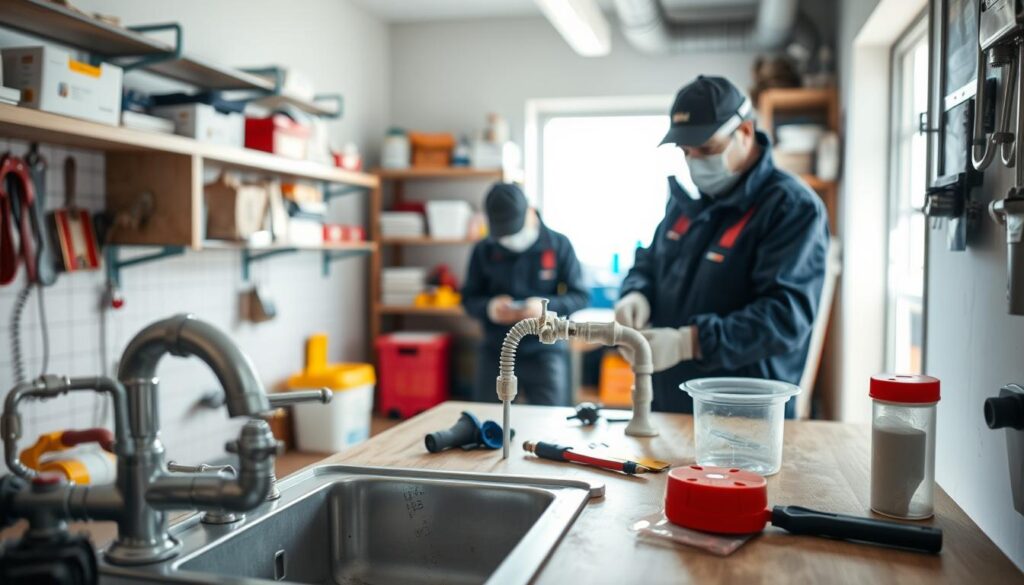
Before starting any plumbing repair, it’s crucial to ensure you’re taking the necessary safety precautions. DIY plumbing repairs can be challenging, but with the right safety measures, you can avoid injuries and ensure a successful fix.
Always Shut Off the Water Supply
One of the most critical safety tips for quick and easy plumbing repairs is to shut off the water supply. This simple step can prevent water damage and reduce the risk of injury. Locate the shut-off valves and turn them clockwise to shut off the water supply to the affected area. It’s essential to verify that the water supply is completely shut off before beginning your repair.
Use Protective Gear
Wearing protective gear is another vital aspect of safety during DIY plumbing repairs. Gloves will protect your hands from sharp edges and harsh chemicals, while safety goggles will shield your eyes from debris. Additionally, wearing a mask can protect you from inhaling dust and other particles. Ensuring you’re properly equipped will make your fast plumbing services experience safer and more efficient.
By following these safety tips, you can confidently tackle DIY plumbing repairs, knowing you’re taking the necessary precautions to protect yourself and your property.
Knowing When to Call a Professional
While many plumbing problems can be tackled on your own, some situations require the expertise of a professional plumber. Understanding when to seek help is crucial to prevent minor issues from becoming major problems.
Signs of Serious Plumbing Issues
Certain signs indicate that a plumbing issue is beyond a simple DIY fix. These include persistent leaks, significant water damage, and complex pipe issues that require specialized tools and expertise. If you notice any of these signs, it’s time to seek emergency plumbing solutions.
- Water pressure that’s too high or too low
- Recurring clogs or slow drains
- Visible water damage or warping of floors and walls
Cost Considerations
While hiring a professional plumber comes with a cost, it’s essential to consider the long-term savings. A professional can fix the problem correctly the first time, reducing the likelihood of future repairs. Moreover, they can provide guidance on maintenance to prevent future issues.
| DIY Repair | Professional Repair |
|---|---|
| Initial cost savings | Higher upfront cost |
| Risk of incorrect fix | Guaranteed workmanship |
| Potential for future repairs | Long-term solution |
When searching for a plumber, look for a reliable plumber near me to ensure quick response times and personalized service. This can make a significant difference in emergency situations.
Eco-Friendly Plumbing Repairs
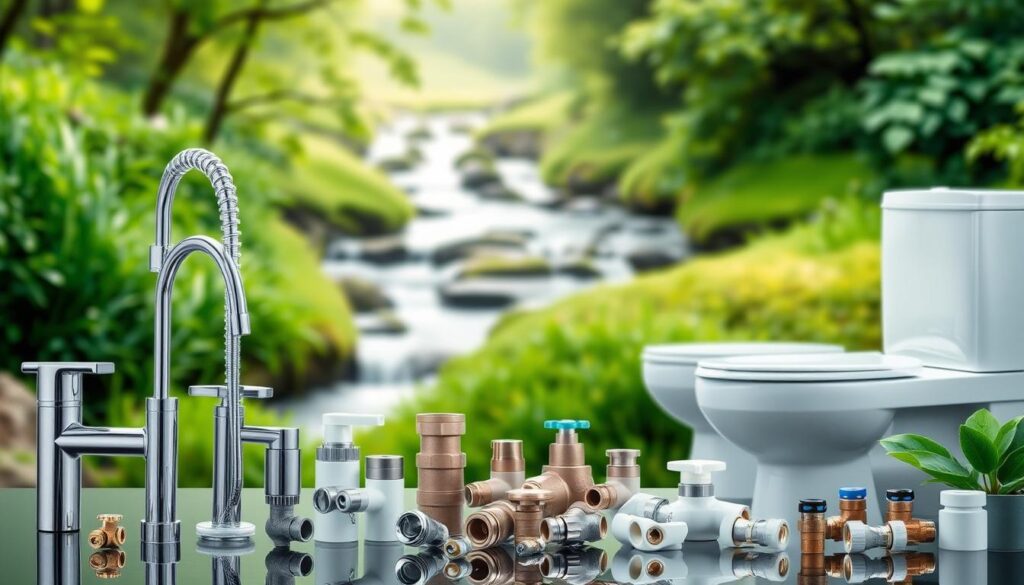
Embracing eco-friendly plumbing repairs is a step towards a more sustainable future. By incorporating green practices into your plumbing routine, you can significantly reduce water waste and lower your utility bills. This approach not only benefits the environment but also enhances the efficiency of your plumbing system.
Water-Saving Fixtures
One of the simplest ways to make your plumbing more eco-friendly is by installing water-saving fixtures. These include low-flow showerheads, faucets, and toilets that use significantly less water without compromising performance. For instance, a low-flow toilet can save up to 1.6 gallons per flush compared to older models.
| Fixture | Water Savings | Benefits |
|---|---|---|
| Low-Flow Showerheads | Up to 2.5 gallons per minute | Reduces water heating costs |
| Low-Flow Toilets | Up to 1.6 gallons per flush | Significant water savings |
| Faucet Aerators | Up to 1.5 gallons per minute | Reduces splashing and saves water |
For more information on eco-friendly plumbing practices, you can visit https://showtimeexpressplumbing.com/plumbing-blog/eco-friendly-plumbing-repairs-earth-day to explore additional resources and tips.
Green Plumbing Products
In addition to water-saving fixtures, using green plumbing products is another effective way to make your plumbing system more sustainable. These products are designed to be environmentally friendly, using materials that are sustainable and processes that minimize environmental impact.
“The use of green plumbing products is a crucial step towards reducing the environmental footprint of our plumbing systems. By choosing products made from sustainable materials, we can significantly decrease the demand for resource-intensive manufacturing processes.” – Expert in Sustainable Plumbing
Examples of green plumbing products include pipes made from recycled materials, eco-friendly pipe adhesives, and water heaters that use renewable energy sources. By opting for these products, homeowners can contribute to a more sustainable future while also potentially reducing their energy costs.
By adopting eco-friendly plumbing repairs and fixtures, households can make a significant impact on reducing water waste and promoting sustainability. It’s a proactive step towards a greener future, and with the right choices, it’s achievable for everyone.
Preparing for Future Plumbing Problems
Future plumbing problems can be mitigated with the right preparation and knowledge. Being prepared not only saves money but also reduces the stress associated with sudden plumbing emergencies.
Creating a Plumbing Checklist
One of the most effective ways to prepare for future plumbing issues is by creating a comprehensive plumbing checklist. This checklist should include regular maintenance tasks such as inspecting pipes for leaks, checking water pressure, and clearing clogs from drains.
A well-structured checklist helps in identifying potential issues before they become major problems, thus facilitating same-day plumbing repairs when needed.
| Task | Frequency | Notes |
|---|---|---|
| Inspect pipes for leaks | Quarterly | Check under sinks, around toilets, and near water heaters |
| Check water pressure | Bi-Annually | Ensure it’s within the recommended range |
| Clear clogs from drains | As needed | Use a plunger or plumbing snake |
Keeping Essential Tools Handy
Having the right tools on hand is crucial for addressing minor plumbing issues before they escalate. Essential tools include a plunger, pipe wrench, plumber’s tape, and a drain snake.
By keeping these tools handy, homeowners can perform quick fixes and potentially avoid the need for an experienced plumbing contractor for minor issues.
Seasonal Plumbing Tips

To keep your plumbing system running smoothly year-round, it’s vital to understand the seasonal challenges it faces. Different seasons bring different plumbing challenges, and being prepared can save you from costly repairs and ensure the longevity of your plumbing system.
Winter Preparations for Pipes
Winter can be particularly harsh on plumbing systems, with the risk of frozen pipes being a major concern. Frozen pipes can burst, leading to significant water damage and costly repairs. To prevent this, it’s essential to take proactive measures.
- Insulate exposed pipes in unheated areas like the garage, basement, or crawlspace.
- Disconnect and drain hoses from outdoor faucets.
- Seal any cracks or gaps in the walls or foundation with caulk or spray foam.
- Let cold water drip from faucets served by exposed pipes.
For more detailed tips on preparing your plumbing for winter, you can visit this resource for additional guidance.
Summer Maintenance Tasks
Summer is an ideal time to perform routine maintenance on your plumbing system to ensure it’s in good condition before the colder months return. Key tasks include checking for leaks under sinks and around toilets, inspecting your water heater for signs of wear, and cleaning your drains to prevent clogs.
| Task | Frequency | Benefit |
|---|---|---|
| Check for leaks | Monthly | Prevents water damage |
| Inspect water heater | Quarterly | Extends heater lifespan |
| Clean drains | Bi-annually | Reduces risk of clogs |
By staying on top of these seasonal plumbing tips, you can ensure your system operates efficiently and reduce the need for fast plumbing services or affordable pipe repair.
“Regular maintenance is key to a healthy plumbing system. By understanding the challenges different seasons bring, homeowners can take proactive steps to prevent common issues.”
Resources for Plumbing Help and Advice
Whether you’re a DIY enthusiast or a homeowner in need, finding trustworthy plumbing advice is essential. Plumbing issues can range from simple fixes to complex problems, and having the right resources can make all the difference.
For those looking for guidance, online tutorials and guides are invaluable. They provide step-by-step instructions and visual aids to help you tackle various plumbing tasks. You can find tutorials on fixing leaky faucets, unclogging drains, and more.
Online Tutorials and Guides
Websites offering plumbing tutorials often include detailed guides and videos. These resources can help you understand the intricacies of plumbing systems and provide solutions to common issues. When searching online, look for top-rated plumbing company websites or forums where professionals share their expertise.
Local Plumbing Forums
Joining local plumbing forums can connect you with experienced plumbers and DIY enthusiasts. These communities are great for getting advice on finding a reliable plumber near me or discussing the best practices for plumbing repairs. You can ask questions, share your experiences, and learn from others in the community.
By leveraging these resources, you can enhance your plumbing skills and tackle issues with confidence. Whether you’re fixing a minor leak or dealing with a more significant problem, having access to trustworthy advice is invaluable.
Conclusion: Enhancing Your Plumbing Skills
By mastering quick and easy plumbing repairs, you can tackle common plumbing issues with confidence, saving time and money. Being proactive in plumbing maintenance is crucial for preventing major issues that may lead to costly emergency plumbing solutions.
Building Confidence
Gaining confidence in quick repairs enables homeowners to address problems efficiently, reducing the likelihood of further damage. This confidence stems from understanding the essential tools and techniques required for various plumbing tasks.
Proactive Benefits
Being proactive in plumbing maintenance offers numerous benefits, including reduced risk of major plumbing emergencies and extended lifespan of plumbing fixtures. Regular maintenance tasks, such as inspecting pipes and checking water pressure, can help identify potential issues before they become major problems.
By enhancing your plumbing skills and adopting a proactive approach, you can ensure a safe and functional plumbing system, avoiding the need for costly emergency plumbing solutions.
